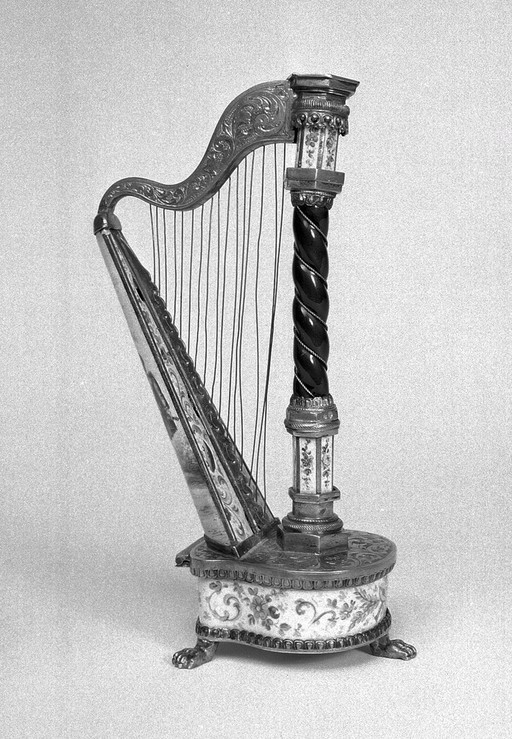Copia di The vibrating string
This activity belongs to the GeoGebra Functions book.
The curious behavior of a vibrating string generated exceptional interest among mathematicians, leading to one of the most heated and fruitful controversies in the history of mathematics.
Until the 18th century, mathematics was not advanced enough to tackle this problem. In 1715, Brook Taylor found that the motion of an arbitrary point on the string is that of a simple pendulum and, as a consequence, the shape of the curve that the string takes at a given instant should be sinusoidal.
18th Century French Harp

Fundamental frequency
But the fundamental sound corresponding to that pendulum vibration is not the only one emitted by the string when it vibrates. Simultaneously, other (partial) sounds of less intensity are produced. The distribution and intensity of these partials (timbre) differentiate instruments or voices that play the same note.
In the case of string and wind instruments, the frequencies of these partials are multiples of the fundamental frequency F. Of these multiples (harmonics), the first is the fundamental frequency itself, the second is double (2F), the third harmonic triple (3F), etc.
A vibrating string
Why exact multiples?
When the string is pressed, a traveling transverse wave is produced, like a wave, that travels along the string towards the ends, with a certain amplitude (maximum separation from the point of rest). There, unable to continue its propagation, it is reflected. This causes two waves reflected at the ends to travel against each other until they overlap on the string.
The sum of these two reflected waves is a longitudinal wave called a standing wave. This name is due to the fact that, when superimposed, the reflected waves seem to stop propagating, becoming an oscillation of the string. (This oscillation is the one that will propagate to the air, and it is the one shown by this application.)
Each reflected wave will have traveled the length of the string twice until it is back at the starting point. So the length of the standing wave is twice the length of the string. Now, when the two transverse waves overlap to form the standing wave, points (nodes) may appear where the waves are 180º out of phase, so at those points, the amplitude will be zero (they do not move). These nodes act as fixed ends of parts of the string, so the vibration of these parts will make a higher sound (with higher frequency).
For nodes to appear, they have to be evenly distributed along the string. Therefore, the lengths of those pieces of string have to be divisors of the total length of the string. As the frequency is inversely proportional to the length, it follows that the new sounds must have a multiple of the fundamental frequency as a frequency, that is, they must be harmonic.
Standing waves on strings
The challenge
Now, the funny thing is that the string does not vary alternately between one harmonic and another, but emits all the harmonic sounds at the same time.
Here is the crux of the question, a cause of intrigue and discussion among mathematicians: how does the string manage to vibrate in several different ways at the same time?
This is what brilliant mathematicians like D'Alembert, Daniel Bernoulli, Euler, Fourier, and Dirichlet were wondering.
When building a guitar neck, it is important that the frets are placed correctly.
As the length of the vibrating string is halved, the frequency doubles, and we hear a sound one octave higher than the open string.
There are 12 notes in an octave(including sharps & flats) and the formula to break the octave up into 12 pieces is to divide the length by 2 1/12
If you input the length of your guitar neck, this will let you know the distances from the bridge to the fret for each note.
Fretboard
Author of the construction and activity: Rafael Losada Liste.
Translated and additions by Tabea Hirzel.
Fretboard by DThomas.
This activity is present in the Gauss Project.